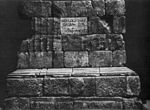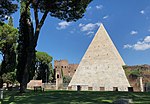Monte Testaccio

Monte Testaccio ([ˈmonte teˈstattʃo]; alternatively spelled Monte Testaceo; also known as Monte dei cocci) is an artificial mound in Rome composed almost entirely of testae (Italian: cocci), fragments of broken ancient Roman pottery, nearly all discarded amphorae dating from the time of the Roman Empire, some of which were labelled with tituli picti. It is one of the largest spoil heaps found anywhere in the ancient world, covering an area of 2 hectares (4.9 acres) at its base and with a volume of approximately 580,000 cubic metres (760,000 cu yd), containing the remains of an estimated 53 million amphorae. It has a circumference of nearly a kilometre (0.6 mi) and stands 35 metres (115 ft) high, though it was probably considerably higher in ancient times. It stands a short distance away from the east bank of the River Tiber, near the Horrea Galbae where the state-controlled reserve of olive oil was stored in the late 2nd century AD. The mound later had both religious and military significance.
Excerpt from the Wikipedia article Monte Testaccio (License: CC BY-SA 3.0, Authors, Images).Monte Testaccio
Via Nicola Zabaglia, Rome Municipio Roma I
Geographical coordinates (GPS) Address External links Nearby Places Show on map
Geographical coordinates (GPS)
| Latitude | Longitude |
|---|---|
| N 41.875952 ° | E 12.475694 ° |
Address
Monte Testaccio (Monte de' Cocci)
Via Nicola Zabaglia
00153 Rome, Municipio Roma I
Lazio, Italy
Open on Google Maps










